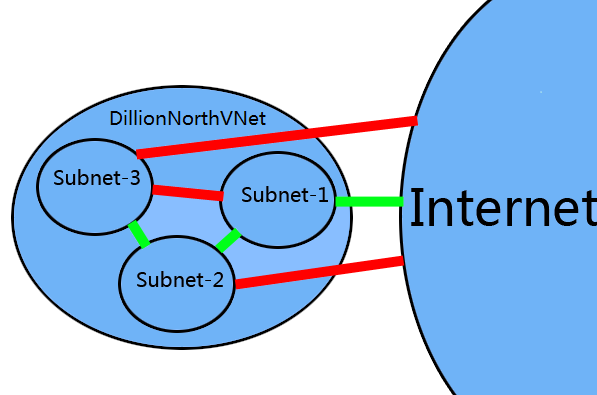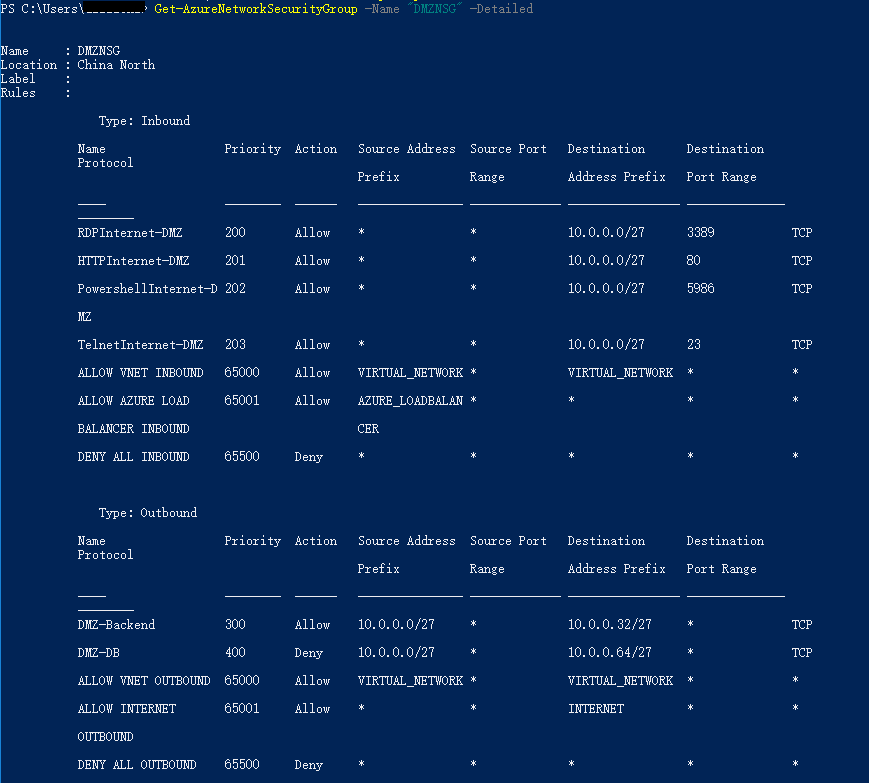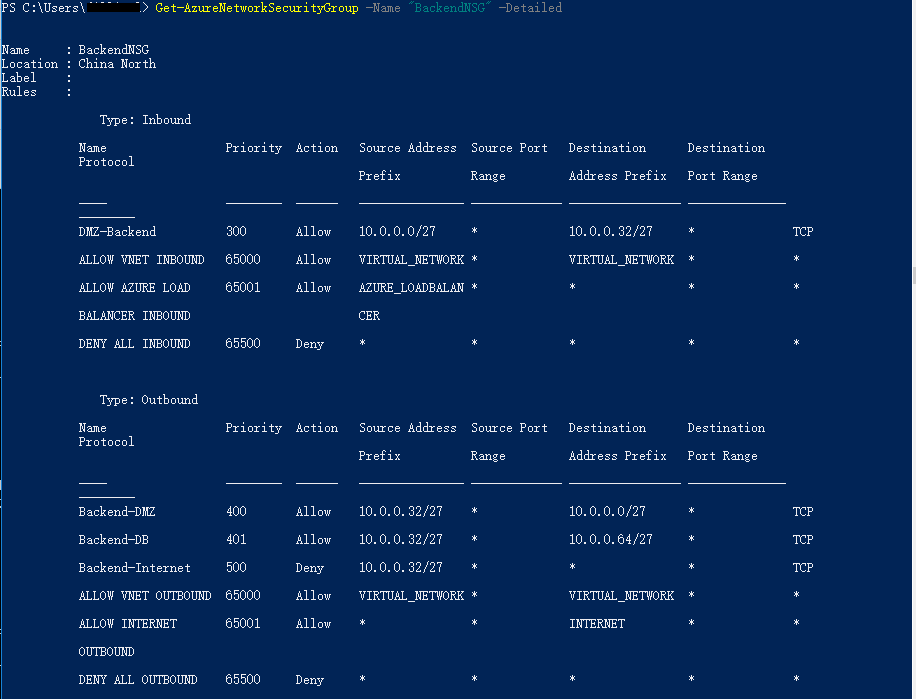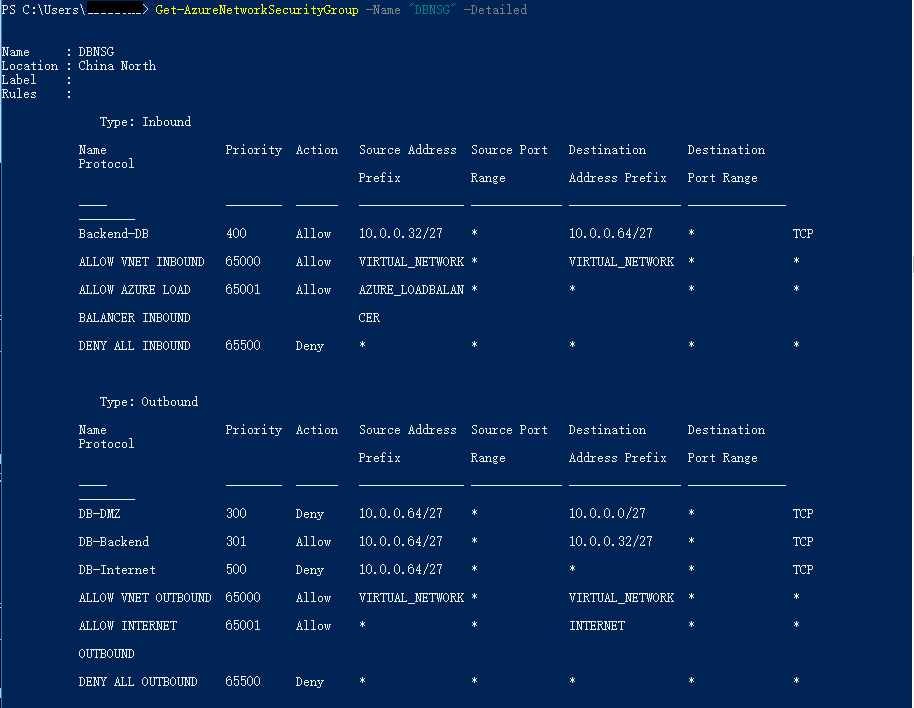使用 NSG 实现 DMZ 区域
详细操作
首先需要创建一个经典虚拟网络:
以如下的网络为例:
资源组名称:
dillionrg虚拟网络(经典)名称:
DillionNorthVNet子网划分:

每个子网部署 1 台虚拟机:

接下来要实现下面的策略:
Subnet-1 面向公网,但是公网仅可以访问 Subnet-1 中虚拟机的 80/5986/3389/23 端口,从 Subnet-1 访问公网不受限。
Subnet-1 可以与 Subnet-2 通信,Subnet-1 不能与 Subnet-3 通信。
Subnet-2 可以与 Subnet-1 和 Subnet-3 通信,Subnet-2 屏蔽掉公网(进出流量都被屏蔽)。
Subnet-3 可以与 Subnet-2 通信,不能与 Subnet-1 通信。Subnet-3 屏蔽掉公网(进出流量都被屏蔽)。
大致的拓扑关系如下(红色表示不通,绿色表示连通):
查看虚拟网络及其子网,获取虚拟网络以及子网名称
Get-AzureVNetSite (Get-AzureVNetSite -VNetName "<虚拟网络名称>").Subnets针对三个子网配置 NSG,脚本如下:
$VNetName = "Group dillionrg DillionNorthVNet"; $Subnet1Name = "Subnet-1"; $Subnet2Name = "Subnet-2"; $Subnet3Name = "Subnet-3"; $DMZNSG = New-AzureNetworkSecurityGroup -Name "DMZNSG" -Location "China East"; $BackendNSG = New-AzureNetworkSecurityGroup -Name "BackendNSG" -Location "China East"; $DBNSG = New-AzureNetworkSecurityGroup -Name "DBNSG" -Location "China East"; # set DMZ zone(Subnet-1) security rules $DMZNSG | Set-AzureNetworkSecurityRule -Name "RDPInternet-DMZ" -Type Inbound -Priority 200 -Action Allow -SourceAddressPrefix * -SourcePortRange * -DestinationAddressPrefix "10.0.0.0/27" -DestinationPortRange 3389 -Protocol TCP; $DMZNSG | Set-AzureNetworkSecurityRule -Name "HTTPInternet-DMZ" -Type Inbound -Priority 201 -Action Allow -SourceAddressPrefix * -SourcePortRange * -DestinationAddressPrefix "10.0.0.0/27" -DestinationPortRange 80 -Protocol TCP; $DMZNSG | Set-AzureNetworkSecurityRule -Name "PowershellInternet-DMZ" -Type Inbound -Priority 202 -Action Allow -SourceAddressPrefix * -SourcePortRange * -DestinationAddressPrefix "10.0.0.0/27" -DestinationPortRange 5986 -Protocol TCP; $DMZNSG | Set-AzureNetworkSecurityRule -Name "TelnetInternet-DMZ" -Type Inbound -Priority 203 -Action Allow -SourceAddressPrefix * -SourcePortRange * -DestinationAddressPrefix "10.0.0.0/27" -DestinationPortRange 23 -Protocol TCP; $DMZNSG | Set-AzureNetworkSecurityRule -Name "DMZ-Backend" -Type Outbound -Priority 300 -Action Allow -SourceAddressPrefix "10.0.0.0/27" -SourcePortRange * -DestinationAddressPrefix "10.0.0.32/27" -DestinationPortRange * -Protocol TCP; $DMZNSG | Set-AzureNetworkSecurityRule -Name "DMZ-DB" -Type Outbound -Priority 400 -Action Deny -SourceAddressPrefix "10.0.0.0/27" -SourcePortRange * -DestinationAddressPrefix "10.0.0.64/27" -DestinationPortRange * -Protocol TCP; # set Backend zone(Subnet-2) security rules $BackendNSG | Set-AzureNetworkSecurityRule -Name "DMZ-Backend" -Type Inbound -Priority 300 -Action Allow -SourceAddressPrefix "10.0.0.0/27" -SourcePortRange * -DestinationAddressPrefix "10.0.0.32/27" -DestinationPortRange * -Protocol TCP; $BackendNSG | Set-AzureNetworkSecurityRule -Name "Backend-DMZ" -Type Outbound -Priority 400 -Action Allow -SourceAddressPrefix "10.0.0.32/27" -SourcePortRange * -DestinationAddressPrefix "10.0.0.0/27" -DestinationPortRange * -Protocol TCP; $BackendNSG | Set-AzureNetworkSecurityRule -Name "Backend-DB" -Type Outbound -Priority 401 -Action Allow -SourceAddressPrefix "10.0.0.32/27" -SourcePortRange * -DestinationAddressPrefix "10.0.0.64/27" -DestinationPortRange * -Protocol TCP; $BackendNSG | Set-AzureNetworkSecurityRule -Name "Backend-Internet" -Type Outbound -Priority 500 -Action Deny -SourceAddressPrefix "10.0.0.32/27" -SourcePortRange * -DestinationAddressPrefix * -DestinationPortRange * -Protocol TCP; # set DB zone(Subnet-3) security rules $DBNSG | Set-AzureNetworkSecurityRule -Name "DB-DMZ" -Type Outbound -Priority 300 -Action Deny -SourceAddressPrefix "10.0.0.64/27" -SourcePortRange * -DestinationAddressPrefix "10.0.0.0/27" -DestinationPortRange * -Protocol TCP; $DBNSG | Set-AzureNetworkSecurityRule -Name "DB-Backend" -Type Outbound -Priority 301 -Action Allow -SourceAddressPrefix "10.0.0.64/27" -SourcePortRange * -DestinationAddressPrefix "10.0.0.32/27" -DestinationPortRange * -Protocol TCP; $DBNSG | Set-AzureNetworkSecurityRule -Name "Backend-DB" -Type Inbound -Priority 400 -Action Allow -SourceAddressPrefix "10.0.0.32/27" -SourcePortRange * -DestinationAddressPrefix "10.0.0.64/27" -DestinationPortRange * -Protocol TCP; $DBNSG | Set-AzureNetworkSecurityRule -Name "DB-Internet" -Type Outbound -Priority 500 -Action Deny -SourceAddressPrefix "10.0.0.64/27" -SourcePortRange * -DestinationAddressPrefix * -DestinationPortRange * -Protocol TCP; # apply the rules to associated subnets $DMZNSG | Set-AzureNetworkSecurityGroupToSubnet -VirtualNetworkName $VNetName -SubnetName $Subnet1Name; $BackendNSG | Set-AzureNetworkSecurityGroupToSubnet -VirtualNetworkName $VNetName -SubnetName $Subnet2Name; $DBNSG | Set-AzureNetworkSecurityGroupToSubnet -VirtualNetworkName $VNetName -SubnetName $Subnet3Name;配置成功后,可以使用下面的命令查看每个 AzureNetworkSecurityGroup 的规则:
Get-AzureNetworkSecurityGroup -Name "DMZNSG" -Detailed Get-AzureNetworkSecurityGroup -Name "BackendNSG" -Detailed Get-AzureNetworkSecurityGroup -Name "DBNSG" -Detailed设置完成后规则列表如下:



PowerShell 指令详解
对下面这个命令的一些参数做一下简单说明:
Set-AzureNetworkSecurityRule -Name "DB-DMZ" -Type Outbound -Priority 300 -Action Deny -SourceAddressPrefix "10.0.0.64/27" -SourcePortRange * -DestinationAddressPrefix "10.0.0.0/27" -DestinationPortRange * -Protocol TCP;
- Name:指定过滤规则的名称
- Type:Inbound和Outbound,指相对 VM 或者 Subnet 而言是向内还是向外的流量
- Priority:规则的优先级,值越小越先匹配
- Action:Allow 和 Deny,指如果规则匹配,那么允许或者拒绝该流量
- SourceAddressPrefix 和 DestinationAddressPrefix:访问的源和目的 IP 段,通常有下面几种取值:
- CIDR 地址:例如 10.0.0.0/27 这种子网网段或者公网 IP 段都可以
- *:表示任何 IP
- VIRTUAL_NETWORK:表示所在虚拟网络内的 IP 地址
- INTERNET:公网 IP 地址
- AZURE_LOADBALANCER:Azure 的负载均衡转发过来的流量
- SourcePortRange 和 DestinationPortRange:源和目的端口,通常为具体的端口号或者 *(代表任何端口)
- Protocol:TCP 或者 UDP 协议
关于 NSG 使用的一些说明
- 如果 NSG 应用到虚拟机上,那么必须删除该虚拟机所有的 ACL,即对于虚拟机 ACL 和 NSG 不能并存。
- 如果 NSG 应用到虚拟机所在的子网上,那么仍然可以为虚拟机配置 ACL。
- 配置了 NSG 后,虚拟网络中如果设置了规则的线路就无法 ping 通了(因为规则只允许 TCP 或者 UDP 协议),例如上面的例子中,Subnet-1 和 Subnet-2 中的虚拟机可以使用 Psping 来测试连通性,ping 命令会超时。
- 当设置规则的时候,对于虚拟机或者虚拟网络来说,指定开放或者屏蔽端口的时候,需要使用内网端口,不存在 NAT 转换。